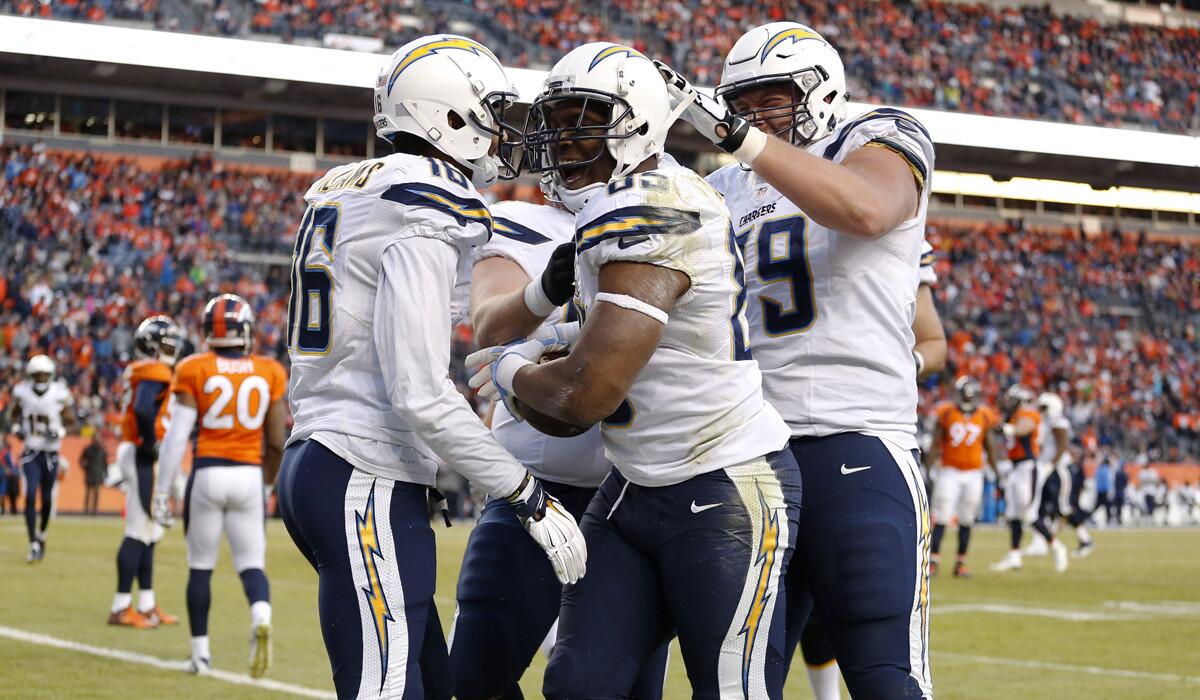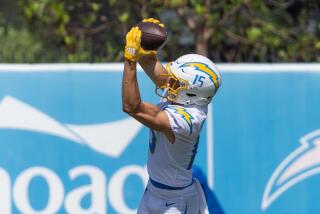If Chargers move here, it seems likely they’d be Stan Kroenke’s tenant

San Diego Chargers tight end Antonio Gates (85) celebrates a touchdown with teammates during the second half against the Denver Broncos on Jan. 3.
- Share via
The San Diego Chargers have insisted for nearly a year that they wanted to be an equal partner in a Los Angeles stadium were they to move north. But if they choose to relocate, there is a strong likelihood that it will be as a tenant paying $1 per year to play in Rams owner Stan Kroenke’s planned Inglewood stadium.
A deal between the Chargers and Rams seems inevitable, but an agreement doesn’t guarantee that the Chargers will play in L.A. for the 2016 season — or ever.
The basic structure of the NFL-brokered arrangement hasn’t changed in the 2 1/2 weeks since owners approved the Rams’ relocating and building a new stadium in Inglewood. Now everyone is waiting for the Chargers, who have a one-year option to move to L.A., to make up their minds.
See more of our top stories on Facebook >>
Negotiations between staffers from the Rams and Chargers — Kroenke and Chargers owner Dean Spanos aren’t directly participating — started in L.A. on Jan. 18. Both teams declined to comment on the discussions.
The situation is seen as less of a back-and-forth negotiation than a choice confronting the Chargers.
Multiple individuals familiar with the league’s position, as well as the ongoing discussions between the teams, revealed details to The Times on the condition they not be identified.
In a statement Thursday announcing plans for a potential interim training facility on five acres in Santa Ana, the Chargers said that “no final decision on relocation has been made.”
Time is of the essence. The Rams have already established a foothold in L.A., accepting more than 50,000 refundable deposits from people interested in buying between one and eight season tickets to watch the team at its temporary home in the Coliseum.
The discussions between the Rams and Chargers continue as attention builds for Super Bowl 50 in Santa Clara on Feb. 7. The NFL prefers not to have any news upstage the game between the Carolina Panthers and Denver Broncos.
There are two plausible strategies for the Chargers. They could agree to a deal and move to L.A. for the 2016 season — a choice that must be made by March 23 — or accept a deal in principle with the idea of restarting negotiations for a new stadium in San Diego and keep L.A. as a fallback.
“The door is open for a San Diego solution,” a spokesman for San Diego Mayor Kevin Faulconer said. “We have a fair plan in San Diego. … The mayor remains ready to resume talks.”
For now, the Chargers are talking to the Rams.
The framework for a landlord-tenant agreement between the teams was put in place earlier this month by the NFL’s finance, L.A. and stadium committees. It was one of several contingencies discussed the week before the full complement of owners voted on L.A.
The foundation of the proposed deal for the Chargers as a tenant involves two theoretical buckets that contain various revenue streams.
One bucket has seldom-sold assets connected to the stadium such as naming rights and personal seat licenses from both teams. The $200-million loan each team would receive from the NFL toward stadium construction would go in the bucket, along with revenue from non-football events like soccer matches and conventions.
Most of the first bucket would go to pay off the multibillion-dollar stadium. Each team would receive a percentage of revenues from that bucket. The league has suggested 18.75% for each team.
The second bucket contains annually sold items connected to the teams such as tickets, game-day sponsorships, signage, concessions and parking. Each team retains its revenue from that bucket.
Those familiar with the arrangement say it makes far more sense for the second team to be a tenant instead of a co-owner in what is expected to be the most expensive stadium in U.S. history. As a tenant, the Chargers would share in some of the financial reward without assuming any of the risk.
Much of Kroenke’s financial windfall will be as a result of mixed-use development surrounding the stadium on the 298-acre site. The NFL has not asked Kroenke to allow Spanos to be a partner in the larger development.
Kroenke benefits from adding a second team in a number of ways. There’s the additional $200-million loan from the NFL and personal-seat-license money to help finance the stadium. The second team also doubles the number of NFL dates on the site, bringing more people to the entire complex.
Like the Rams, the Chargers would be required to pay a $550-million relocation fee. It can be paid over 10 years, starting in 2019 when the Inglewood stadium opens. That money would be distributed evenly among the 30 teams that aren’t moving.
Twitter: @LATimesFarmer
Twitter: @nathanfenno
MORE SPORTS NEWS
Lakers hear it from fans in listless 114-91 loss to Bulls at Staples Center
Good time turned ugly after teasing for Blake Griffin and Clippers assistant
Plaschke: Do the Dodgers really want their fans to miss Vin Scully’s final season?
More to Read
Go beyond the scoreboard
Get the latest on L.A.'s teams in the daily Sports Report newsletter.
You may occasionally receive promotional content from the Los Angeles Times.












